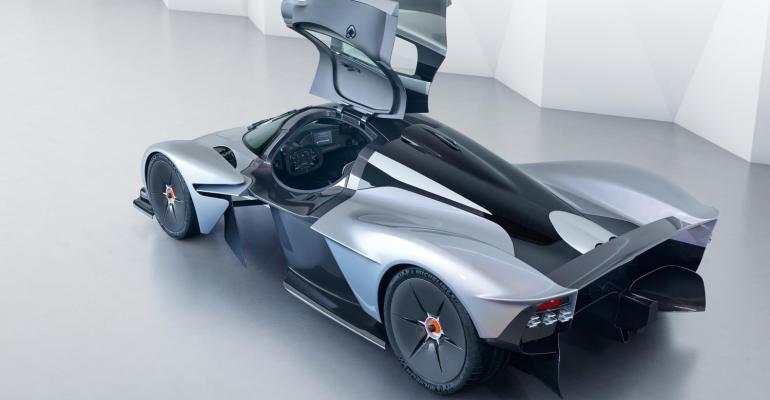GAYDON, U.K. – Aston Martin releases the latest pictures and new details of the £2.5M ($3.2M) Valkyrie hypercar expected to hit the streets in 2019.
The car, said by the automaker to be bristling with more Formula One-derived technology than any supercar to date, is a collaboration between Aston Martin and Red Bull Advanced Technologies, with team boss Adrian Newey and project partner AF Racing.
Its design is dictated by high-speed aerodynamics and so the Valkyrie’s teardrop-shaped cockpit’s upper body surfaces and lower tub contours follow the envelope of space available between the full-length Venturi tunnels running along either side of the cockpit floor. Drawing large quantities of air beneath the car to feed the rear diffuser, these tunnels generate massive downforce without the need for external body wings.
Extreme racing also influences the occupants’ seating position, which is a Formula One and Le Mans Prototype “feet-up” position that also liberates more cabin space.
A 4-point harness comes as standard, while an optional 6-point harness will be offered for those who intend to do more track driving.
Switchgear is placed on the steering wheel, with all the vital signs shown on a single OLED display screen. The steering wheel is detachable, both to help the driver getting in and out of the cabin and as an additional security device.
To avoid unwanted aerodynamic disturbance, traditional door mirrors are replaced by discreetly mounted rear-facing cameras in each of the Valkyrie’s flanks. These feed two displays which are positioned at the base of each A-pillar to mimic the view provided by conventional door mirrors.
The all-enveloping bodywork and roof-mounted engine air intake means there is no rear window, and so there is no rearview mirror.
“It’s been a tremendous challenge to make the interior packaging work,” Matt Hill, Aston Martin creative director-interiors, says of the Valkyrie’s cockpit design. “We’ve embraced Red Bull Racing’s Formula One ethos and approached from a different angle than conventional road-car design.
“In this instance, we’ve started from a position where you think something is impossible and work at it until you find a way to make it work. We’ve been fighting for millimeters everywhere, but the battle has been worth it, as it’s been fantastic seeing customers try the interior buck for size.
“They love the ritual of getting in and how it feels to be sat behind the wheel,” Hill says. “They’re also genuinely surprised at how the car just seems to swallow them. You really do have to sit in it to believe there is genuine space for two large adults.”
One of the most striking exterior features are the headlamps. Aston Martin designers stripped things back to the bare essentials, celebrating the engineering. With the low- and high-beam elements attached to exposed anodized aluminum they are between 30%-40% lighter than the lightest series-production headlamps currently available to the automaker.
Even the famous hood badge receives the lightweighting treatment, with the design team deciding to chemically etch an aluminum badge just 70 microns thick – 30% thinner than a human hair and 99.4% lighter than the regular enamel wings badge.
At the back, the center high-mounted brake light is mounted on the tip of the small shark’s fin that runs down the spine of the Valkyrie’s airbox and rear bodywork. The LED light is just 0.2 in. (5.5 mm) wide and 0.4 in. (9.5 mm) high and is the world’s smallest such lamp.
“I would say we’re around 95% of the way there with the exterior design,” Miles Nurnberger, Aston Martin creative director-exterior design, says of the Valkyrie’s design evolution. “Much of what you see is actually the structure of the car, so this had to be signed-off relatively early in the project. The remaining areas of non-structural bodywork are still subject to evolution and change as Adrian (Newey) continues to explore ways of finding more downforce.
“The new outlets in the body are a case in point. Ordinarily the last thing we’d want to do to one of our surfaces is cut a hole in it, but these vents work the front wings so much harder that they’ve found a significant gain in front downforce. The fact that they are so effective gives them their own functional beauty, but we’ve finessed them without impacting on their functionality.
“That they also serve as windows through which to view the fabulous wing section front wishbones is a welcome bonus.”
More details about the car’s powertrain, rumored to be a Cosworth-developed naturally aspirated V-12, will be published later.





